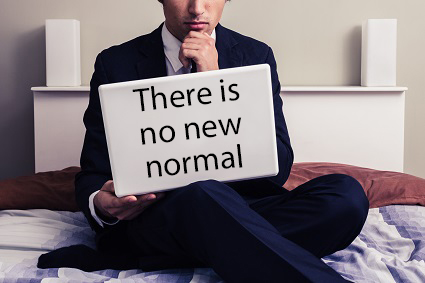Your cart is currently empty!

There Is No New Normal
I was talking today with Megan, a Hearst representative, someone who works with both digital and legacy marketing. We were discussing ad placement in news, both digital and legacy. I looked around the coffee shop where we met and realized that each person in our view might get news in a different way. When it comes to news delivery, we know that the previously normal method of reading the newspaper in the morning and watching the news on TV in the evening is no longer the norm. But what is? Really, there is no new normal.
Megan gets news on her phone. Not optimal, I suggested. Why would you want to read a 3 x 5″ screen if you have access to a larger screen? Because, Megan said, her phone is her connection with the world. Her phone is with her all the time, including when she wants news, so that’s where she’s going to look for news, on a few apps. She puts the TV news on in the background sometimes, especially since she works for a TV station, but that doesn’t mean she’s watching. News, along with almost all other input that matters in her life, comes from her phone.
Rosie gets her news on her phone, too, but she gets it from Facebook rather than news apps. She follows her favorite news sources on Facebook, and clicks through if she wants to learn more. Unlike most of the people I asked, Rosie uses a single source for all her news — but it’s a great aggregator. Pew Research says that 63% of Facebook users ( a group that includes most adults in the U.S.) claim it as a news source.
Me, I check the headlines on the Wall Street Journal’s video news service on my TV via Roku in the mornings while I have breakfast, and get the details of the most interesting stories from Google news once I get to my desktop computer. I get alerts on my phone via gmail for topics I want to know about — and again, I read them on my desktop if I want the full story. I also listen to NPR when I’m in my car… unless I’m listening to an audio book on my Kindle, which is hooked up to my car stereo. Industry news? I get that from Twitter.
Tell us in the comments how you get your news. I bet there are very few matches. The way we get our news may not be as individual as snowflakes, but there are so many options and combinations of apps, devices, media, and paths from headlines to full stories that I haven’t heard two matching answers yet.
Why does this matter for your online marketing? Here’s the takeaway: drop your ideas about how people get news. If you want to connect your marketing with news sources by buying ads connected to news sources online or elsewhere, plan to do some research first. Don’t assume that Google News or the 6:00 local TV news or Snapchat is your customer’s top source of news just because it’s yours. In fact, you have to assume that your customers are essentially unique in the ways they get their news.
Identify the demographics for the news sources you’re considering, but don’t put all your eggs in one basket. It may be that in the future we as a community will settle on some new normal way to get news — theSkimm with a Twitter chaser, maybe, or LinkedIn Pulse and Facebook in tandem, or something that doesn’t exist yet. Until that happens, and as far as the news is concerned, there is no new normal.
by
Tags:

Leave a Reply